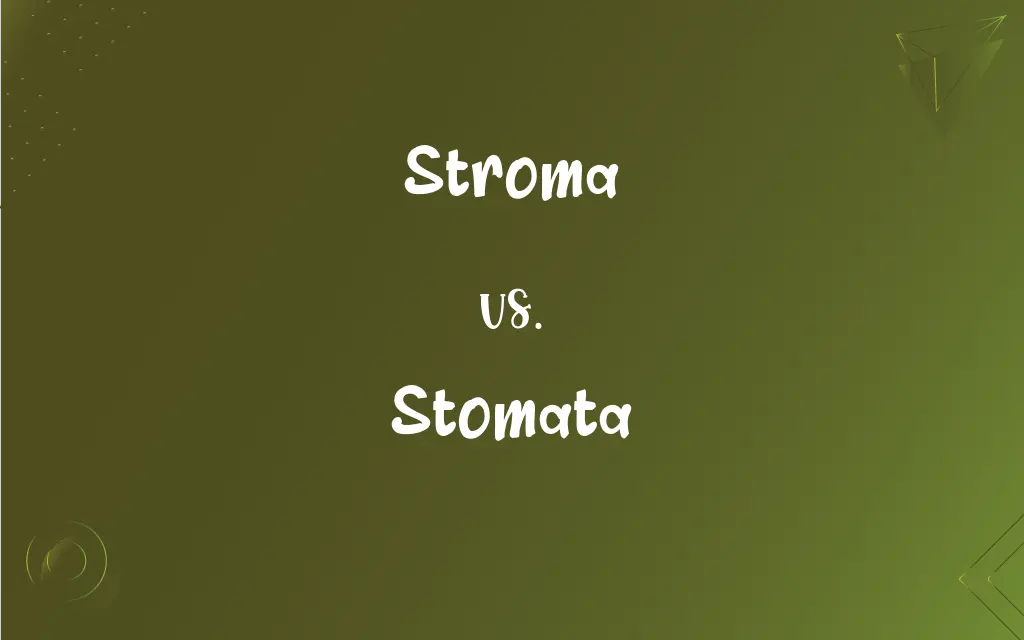Stroma vs. Stomata: What's the Difference?
By Janet White || Published on February 25, 2024
Stroma is the supportive tissue of an organ, whereas stomata are tiny openings on plant leaves for gas exchange.

Key Differences
The stroma, in biology, refers to the supportive framework of a biological cell, organ, or tissue, composed mainly of connective tissue. Stomata, on the other hand, are microscopic pores found on the surface of leaves and stems of plants, crucial for the process of photosynthesis and transpiration.
In the context of chloroplasts in plant cells, the stroma is the dense fluid within the chloroplast, surrounding the thylakoid membranes. It's where the light-independent reactions of photosynthesis occur. Stomata, however, are involved in the gas exchange process, regulating the entry of carbon dioxide and the exit of oxygen and water vapor.
The stroma in human anatomy refers to the connective and supportive tissue of organs, different from parenchyma, which is the functional part. Stomata, exclusive to plant biology, facilitate the process of transpiration, which helps in cooling the plant and maintaining nutrient flow.
In the eye, the stroma refers to the middle, thickest layer of tissue in the cornea. In contrast, stomata, not found in animals, are integral to the regulation of gas exchange and water balance in plants, adapting to environmental conditions by opening and closing.
The stroma in organs like the liver and kidney provides structural integrity and houses blood vessels and nerves. Stomata, through their opening and closing, mediated by guard cells, play a vital role in a plant's response to environmental stress.
ADVERTISEMENT
Comparison Chart
Definition
Supportive tissue of organs or fluid in chloroplasts.
Pores on leaf surface for gas exchange.
Location
In organs and chloroplasts.
On plant leaves and stems.
Function
Provides structure or site for reactions.
Facilitates gas exchange and transpiration.
Presence in Organisms
In both plants (chloroplasts) and animals (organ tissue).
Only in plants.
Response to Environment
Not directly responsive.
Open/close in response to environmental conditions.
ADVERTISEMENT
Stroma and Stomata Definitions
Stroma
Connective tissue component of organs.
The stroma in the kidney encapsulates the functional nephrons.
Stomata
Microscopic pores on plant leaves for gas exchange.
Stomata open during the day to allow carbon dioxide into the leaf.
Stroma
Middle layer of tissue in the cornea.
The stroma layer in the cornea is essential for vision.
Stomata
Integral to plant water balance and cooling.
When stomata are open, transpiration cools the plant.
Stroma
Supportive framework of a biological cell, organ, or tissue.
The stroma in the liver provides structural support to the organ.
Stomata
Openings involved in photosynthesis and transpiration.
Stomata close at night to reduce water loss.
Stroma
Structural part of a biological entity, contrasting with functional parts.
The stroma in the pancreas surrounds the insulin-producing cells.
Stomata
Regulated by guard cells for environmental adaptation.
Stomata open wider in high light to maximize photosynthesis.
Stroma
Dense fluid inside chloroplasts in plant cells.
The stroma in chloroplasts is where the Calvin cycle takes place.
Stomata
Responsive to external stimuli like light and humidity.
Stomata close in response to drought conditions to conserve water.
Stroma
The connective tissue framework of an organ, gland, or other structure, as distinguished from the tissues performing the special function of the organ or part.
Stomata
A plural of stoma.
Stroma
The spongy, colorless framework of a red blood cell or other cell.
Stroma
The colorless semiliquid material inside a chloroplast, in which the thylakoid membranes are embedded and where the dark reactions of photosynthesis occur.
Stroma
A dense mass of fungal hyphae on or in which reproductive structures develop.
Stroma
(anatomy) The tissue structure of an organ, etc., that serves to support it.
Stroma
The connective tissue or supporting framework of an organ; as, the stroma of the kidney.
Stroma
A layer or mass of cellular tissue, especially that part of the thallus of certain fungi which incloses the perithecia.
Stroma
The dense colorless framework of a chloroplast
Stroma
The supporting tissue of an organ (as opposed to parenchyma)
FAQs
What are stomata?
Stomata are microscopic openings on plant leaves for gas exchange.
What is stroma in biology?
Stroma is the supportive tissue in organs or the fluid inside chloroplasts in plants.
Where is the stroma found?
In organs as connective tissue or in chloroplasts in plants.
How do stomata function?
They regulate gas exchange and water loss in plants.
Does stroma have a role in photosynthesis?
Yes, in the light-independent reactions.
Can stroma be found in all plants?
Only in plants with chloroplasts.
Are stomata visible to the naked eye?
No, they are microscopic.
What gases do stomata regulate?
Mainly oxygen and carbon dioxide.
What is the main function of stroma in organs?
Providing structural support and housing blood vessels and nerves.
Do stomata contribute to plant cooling?
Yes, through transpiration.
Is stroma present in animals?
Yes, as connective tissue in organs.
Is the stroma active in metabolism?
In plants, it's involved in the Calvin cycle.
How do stomata affect plant growth?
By regulating gas exchange, they impact photosynthesis and growth.
What controls the opening of stomata?
Guard cells, responding to environmental stimuli.
Do stomata exist in aquatic plants?
Yes, but their function and structure might differ.
How does stroma differ in plants and animals?
In plants, it's a fluid in chloroplasts; in animals, it's connective tissue.
What environmental factors affect stomata?
Light, humidity, and CO2 levels.
Is stroma involved in vision?
Yes, in the cornea of the eye.
Can the stroma regenerate in organs?
It depends on the organ and injury.
Do all plant leaves have stomata?
Most do, but their number and distribution vary.
About Author
Written by
Janet WhiteJanet White has been an esteemed writer and blogger for Difference Wiki. Holding a Master's degree in Science and Medical Journalism from the prestigious Boston University, she has consistently demonstrated her expertise and passion for her field. When she's not immersed in her work, Janet relishes her time exercising, delving into a good book, and cherishing moments with friends and family.































































